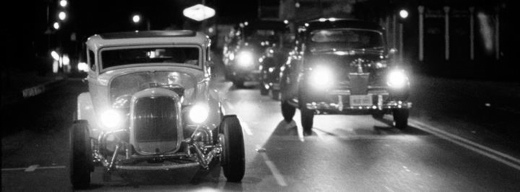Hey gang. 'Sup? Hope all of you are enjoying this Winter. Sometimes I forget how fortunate I am to live in the Central Valley of Northern California where it stays relatively warm during the Winter months. I say relatively because I've been following the news and some of those on the East Coast are enduring some brutally cold weather. My best thoughts go out to those of you who are effected by the cruelties of Mother Nature. Any hoo, since the last post regarding my opinion on revisionist history was challenged by some of my readers, this post focuses on something that's not debatable: The fact that all four of the main cars that were featured in the film, American Graffiti were built to period specs. And, we've got the evidence to prove it: The J.C. Whitney Auto Parts Catalog.
_____________________________________________________
PERIOD CORRECT GRAFFITI CARS
By guest contributor, Charlie Lecach
 If you know something about vintage cars and if you’re a die-hard American Graffiti fan, you’ll notice a few anachronisms while watching the movie, which is set in 1962. Nothing really dramatic, just a few post-62 models here and there in the background, ranging from a ’67 Chevy Impala to a ’73 Olds Cutlass. Anyhow, let’s come to the real heroes of this great movie, besides the actors and the music : The four “main cars” which are Milner’s deuce coupe, Steve’s ’58 Impala, Falfa’s ’55 Chevy and the Pharaoh’s ’51 Merc. When checking out a 1962 edition of “J.C. Whitney’s automotive accessories and parts” catalog, you can notice that all of these cars have been built according to period specs.
If you know something about vintage cars and if you’re a die-hard American Graffiti fan, you’ll notice a few anachronisms while watching the movie, which is set in 1962. Nothing really dramatic, just a few post-62 models here and there in the background, ranging from a ’67 Chevy Impala to a ’73 Olds Cutlass. Anyhow, let’s come to the real heroes of this great movie, besides the actors and the music : The four “main cars” which are Milner’s deuce coupe, Steve’s ’58 Impala, Falfa’s ’55 Chevy and the Pharaoh’s ’51 Merc. When checking out a 1962 edition of “J.C. Whitney’s automotive accessories and parts” catalog, you can notice that all of these cars have been built according to period specs.
Let’s start with the chrome plated reversed wheels, available for Fords and Chevys according to J.C. Whitney. Three out of four of the above mentioned cars are rolling on these wheels. The Mercury has stock wheels with Fiesta hub caps, which have been painted to match the car’s color. Remember the white fur on the Merc’s rear deck mat? It’s listed on page 71 of the 1962 J.C. Whitney catalog. Of course, if you had a car club like the Pharaohs, you could order a plaque custom made to your club’s name or logo through J.C. Whitney.

Even though it’s just mildly customized, Steve Bolander’s ’58 Impala has shaved door handles, ’59 Cadillac bullets in the stock tail lights and a “California rake”. No problem to find any parts for lowering the suspensions or install some door poppers, thanks to J.C. Whitney. Same goes for the Caddy type bullets, available on page 67 if you had the 1962 edition. In the 1959 catalog, on page 74, you had the choice between 2 or 3 inch wide fuzzy dice, like those hanging in Steve’s Chevy. The same page also describes a plastic skull called “Chattering Charlie” a “realistically produced” plastic skull, to hang on your inside rear view mirror. Sounds familiar? Just ask Bob Falfa!


Now about John Milner’s hot rod: let’s forget his alternator for a minute and look for a pair of finned “no name” valve covers. You could get them on page 75 for about $ 33. His front wheel hot rod fenders were available on page 97 in different shapes and sizes. The piston gearshift knob was sold for $ 1.75 and was installed with a plastic bushing and a set screw. In other words, it was probably quite easy to pull it off the shift lever to give it as a gift to young Carol! Even the Man-A-Fre 4 carb. manifold, which was advertised in Hot Rod Magazine in February ’61. The “professional type racing air cleaner stacks” were already a classic from J.C. Whitney and could easily be attached to Milner’s Rochester carburetors.
Let’s face it, while he was buying or modifying the movie cars, transportation manager Henry Travers probably didn’t check out the period accuracy of each listed part installed. Nevertheless, he did a great job and this transportation manager really transported each one of us into the early sixties!
 |
| The '32 Ford coupe's engine (probably a 283) was equipped with finned valve covers which were readily available for many engine sizes in the JC Whitney catalog |











